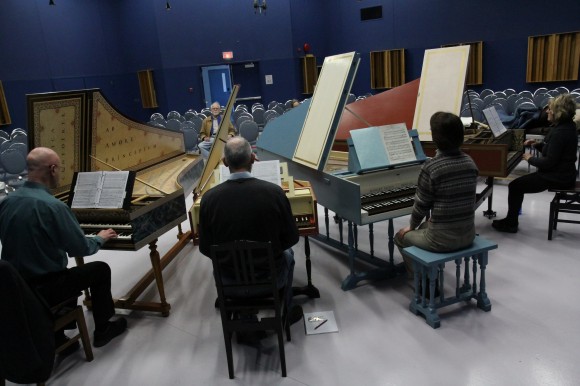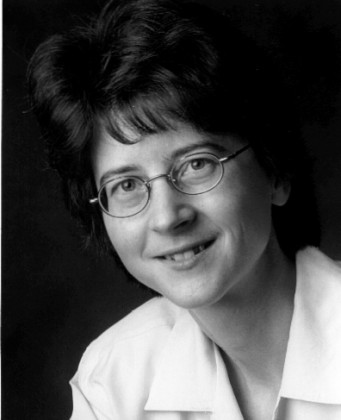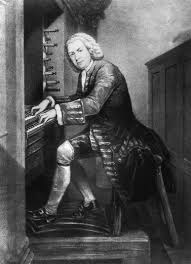HARPSICHORDIA! Antique instruments fight for cool factor at Early Music Festival
Posted on April 10, 2013 By Mike Ross Entertainment, Front Slider, Music, music
 You won’t find a musical instrument as misunderstood and maligned as the harpsichord – not the doleful bassoon, not the dreaded dulcimer, not even the hideous pipes, the pipes, the pipes calling from glen to glen and down the mountainside are as hated as the harpsichord.
You won’t find a musical instrument as misunderstood and maligned as the harpsichord – not the doleful bassoon, not the dreaded dulcimer, not even the hideous pipes, the pipes, the pipes calling from glen to glen and down the mountainside are as hated as the harpsichord.
Avant-garde composer John Cage compared the harpsichord’s buzzy chime to a sewing machine. Famed conductor Thomas Beecham famously said it sounds like like “two skeletons copulating on a corrugated tin roof” or “playing a birdcage with a toasting fork.” As critic Joe Queenan noted, the harpsichord evokes little more than long evenings in drafty French churches to the tune of Vivaldi – “music for the king’s supper.” He added, “If Bach were alive today, there is no way he would choose to have his music performed on the harpsichord, as it as an unbelievably annoying instrument, the Baroque equivalent of the accordion.”
Wendy Markosky, Doctor of Music, has heard them all.
An expert in Baroque music and the antique instruments therein, she is part of a historic “harpsichord bash” happening Friday, April 12 at the First Presbyterian Church, just one event in Edmonton’s annual Early Music Festival running through Sunday, April 14. It will be a rare and amazing event: five harpsichordists performing AT THE SAME TIME. Pieces will include “Concerto in C Minor for Four Harpsichords” written by our old friend J.S. Bach, and possibly the only quadruple harpsichord concerto in existence. If anyone in Alberta can offer a spirited defense of the humble harpsichord, it is Professor Markosky.
“I think it is one of the most sensual instruments,” she says, and pauses, at a loss for words. “It really is.”
 Even so, she knows well that people like Mozart and Beethoven ditched the thing as soon as the much superior piano came along – the pinnacle of keyboard evolution that hasn’t been improved upon for more than 200 years. The harpsichord with its string-plucking action was originally designed to mimic the lute, says Markosky, and a lot of people had them in their homes. Not so much anymore.
Even so, she knows well that people like Mozart and Beethoven ditched the thing as soon as the much superior piano came along – the pinnacle of keyboard evolution that hasn’t been improved upon for more than 200 years. The harpsichord with its string-plucking action was originally designed to mimic the lute, says Markosky, and a lot of people had them in their homes. Not so much anymore.
“People don’t have lutes in their homes either,” she says, “But a lot of people have guitars.”
The only time most people hear harpsichords nowadays is in Merchant-Ivory movies or the odd British art rock band that wants to convey the feeling of being at the king’s supper in a drafty French church. The harpsichord concerto market also seems to have dried up, but that has less to do with the instrument as it does with the changing of musical tastes, Markosky insists.
“Even when Bach was alive, things were changing,” she says. “It was a fast development from harpsichord to piano. Part of the reason the harpsichord fell out of favour was that the musical styles changed so much. That sound didn’t work with the new styles of music.”
Yes, “that sound.” Along with innovations like the dominant seventh chord, composers writing for the new-fangled orchestras of the late 18th Century liked “dynamics” – grand swells and stirring crescendos, sudden louds and softs, and “that’s not something the harpsichord does well,” Markosky admits. In fact, pianos were developed because harpsichord makers were trying to improve the harpsichord. Once that happened, the instrument became as antique as a Model-T Ford: Fun to putter around for a while, not for everyday use. Markosky says that people more or less stopped playing Baroque music as soon as the Baroque period was over, around 1750, and retroactive nostalgia did not emerge until well into the 20th Century – thanks to events like the Early Music Festival. “Early music” refers to basically anything that happened prior to 1750, and “the classic era that most people know is actually quite short, only about one generation,” Markosky says.
And we thought modern music fans were fickle.
Could there be a harpsichord revival? Philip Glass – who is a bit more out there than John Cage – actually wrote a harpsichord concerto, though he may have intended it to be ironic. There are still professional harpsichord makers, people still own them, and early music festivals can be found in almost any major city in the world. Markosky is also hosting a harpsichord maintenance workshop on Sunday, and you may laugh at what sort of turnout they’re going to get, but if your buffs come loose from your bellyrails, you can’t just call a piano tuner. Markosky once had to call in a guy from Indiana to service her harpsichord. It behoves the modern harpsichord enthusiast to bone up on the finer points of maintaining and tuning this fascinating, neglected, allegedly sensual instrument.
All told, it may just be a matter of time till the harpsichord enjoys its renaissance, so to speak.
“We’ve seen this throughout the history of music,” Markosky says. “Later generations will often pooh pooh things from earlier generations, and then they get rediscovered by an even later generation that think it’s the coolest thing.”
The recent hipness of the accordion and the banjo on top-40 radio can attest to that. As for Markosky’s young music students at Canadian University College, they haven’t yet made the unfortunate pop culture associations with sewing machines and Vivaldi that paint such a negative stereotype of the harpsichord as the musty, rickety spinster of the stringed instrument family – so there is hope.
“Were at a time now, I think, when people are looking back more to the past, even the earlier past,” Markosky says. “When I show the students some of this stuff, they said, wow, that is so cool. They don’t even associate it with being old. That’s the great thing about young people.”
The Early Music Festival promises lots more than just harpsichords. There will be recorders, sackbuts, viola da gambas and vielles, along with more workshops and concerts with music by Bach, Handel and of course Vivaldi. Click here for complete event information.












